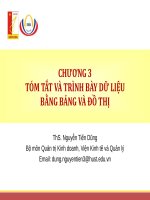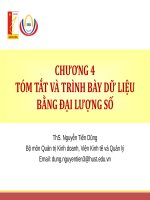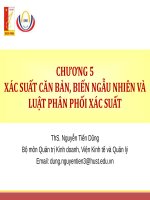Lectures Marketing management: Chapter 11 - ThS. Nguyễn Tiến Dũng
Bạn đang xem bản rút gọn của tài liệu. Xem và tải ngay bản đầy đủ của tài liệu tại đây (1.2 MB, 42 trang )
CHAPTER 11
DEALING WITH COMPETITION
Nguyen Tien Dung, MBA
Email:
Chapter Questions
1. How do marketers identify primary competitors?
2. How should we analyze competitors’ strategies,
objectives, strengths, and weaknesses?
3. How can market leaders expand the total
market and defend market share?
4. How should market challengers attack market
leaders?
5. How can market followers or nichers compete
effectively?
© Nguyễn Tiến Dũng
2
Main Contents
1. Industry Analysis
2. Competitor Analysis
3. Competitive Strategies by Market Position
4. Product Life Cycle Strategies
© Nguyễn Tiến Dũng
3
1. Industry Analysis
● To identify opportunities and threats
associated with the doing business in the
industry
● To determine profitability and risks when
doing business in the industry
● Tool: Five-force model by Michael Porter
© Nguyễn Tiến Dũng
4
Five-Force Model by Michael Porter
© Nguyễn Tiến Dũng
5
Five Forces Determining Segment Structural
Attractiveness
● Industry competitors
● Potential entrant
● Suppliers
● Buyers
● Substitutes
© Nguyễn Tiến Dũng
6
Industry Concept of Competition
● Number of sellers and degree of
differentiation
● Entry, mobility, and exit barriers
● Cost structure
● Degree of vertical integration
● Degree of globalization
© Nguyễn Tiến Dũng
7
Strengths and Weaknesses
● Share of market
● Share of mind
● Share of heart
© Nguyễn Tiến Dũng
8
Steps in Benchmarking
● Determine which functions or processes to
benchmark
● Identify the key performance variables to
measure
● Identify the best-in-class companies
● Measure the performance of best-in-class
companies
● Measure the company’s performance
● Specify programs and actions to close the gap
● Implement and monitor results
© Nguyễn Tiến Dũng
9
2. Competitor Analysis
● 2.1 Identifying competitors
● 2.2 Identifying competitors’ strategies and
objectives
● 2.3 Evaluating competitors’ strengths and
weaknesses
● 2.4 Selecting competitors to attack and avoid
© Nguyễn Tiến Dũng
10
2.1 Identify Competitors
● Industry concept of competitors:
● Market concept of competitors
© Nguyễn Tiến Dũng
11
Industry Concept of Competitors
● Industry concept of competitors:
● An industry is a group of firms that offer a product or class of
products that are close substitutes for one another.
● Competitors are the companies who belong to the same
industry.
● Characteristics of an industry:
● Number of sellers and degree of differetiation
● Entry barrier
● Exit barrier
● Cost structure
● Degree of vertical integration
● Degree of globalization
© Nguyễn Tiến Dũng
12
Number of sellers and degree of differentiation
● Monopoly
● Oligopoly
● Monopolistic competition
● Pure competition
© Nguyễn Tiến Dũng
13
Market Concept of Competitors
● Brand competitors: Lead versus Attila
● Product-form competitors: scooter
motorbikes versus “Honda Cub” motorbikes
● Generic competitors (product-category
competitors): motorbikes versus cars
● Need competitors: transportation needs
versus other needs
© Nguyễn Tiến Dũng
14
2.2 Identifying Competitors’ Strategies and Objectives
● Strategies:
● Few market segments or many market
segments?
● Type of competitive advantages used: low cost or
differentiation?
● Vertical integration: low, medium or high level?
● Objectives:
● Market share first or profit first?
● Which market segments?
© Nguyễn Tiến Dũng
15
Key Principles in “Blue Ocean Strategy”
FORMULATION PRINCIPLES
● a. Reconstruct market boundaries
●
●
●
●
Look across alternative industries
Look across strategic groups within industries II Look across chain of buyers
Look across complementary product and service offerings
Look across functional or emotional appeal to buyers Look across time
● b. Focus on the big picture not the numbers
● c. Reach beyond existing demand
● d. Get the strategic sequence right
● Is there buyer utility?
● Is the price acceptable?
● Can we attain target cost?
● What are the adoption challenges?
EXECUTION PRINCIPLES
● a. Overcome key organizational hurdles
●
●
●
●
Cognitive hurdle
Resource hurdle
Motivational hurdle
Political hurdle
● b. Build execution into strategy
© Nguyễn Tiến Dũng
16
2.3 Evaluating Competitors’ Strengths and Weaknesses
© Nguyễn Tiến Dũng
17
Share of mind, Share of heart, and
Share of market
© Nguyễn Tiến Dũng
18
2.4 Selecting Competitors to Attack and to Avoid
● Strong versus weak
● Close versus Distant
● Good versus Bad
© Nguyễn Tiến Dũng
19
3. Competitive Strategies
● Market leaders
● Market challengers
● Market followers
● Market nichers
© Nguyễn Tiến Dũng
20
3.1. Competitive Strategies for Market Leaders
● Expanding the total market
● New customers
● More usage
● Defending market share: continuous innovation
● Position defense
● Flank defense
● Preemptive defense
● Counteroffensive defense: FedEx vs. UPS
● Mobile defense
● Contraction defense
● Expanding market share
© Nguyễn Tiến Dũng
21
Six Types of Defense Strategies
© Nguyễn Tiến Dũng
22
Counter-offensive Strategy: FedEx vs. UPS
© Nguyễn Tiến Dũng
23
Market Leaders: Ariat
Combining comfort with
rugged wear, Ariat is taking on
the market leaders in the
cowboy boot market.
© Nguyễn Tiến Dũng
24
Leaders’ Strategies: When Your Competitors Delivers
More for Less, p. 300
● Identify market leaders
● K-Mart >< Walmart & Target
● Boots, Sainbury > < ASDA & Tesco
● British Airways > < EasyJet
● What are their strategies to defense their
market position?
● Differentiation: product types, features
● Diversification
● Reduce production costs for easier competition
© Nguyễn Tiến Dũng
25









